The New Yankee Workshop
(1989)Streaming Episode Guide
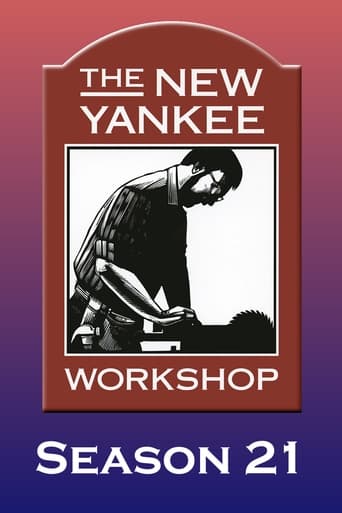
Season 21
The Final Season. The episodes in this season are rebroadcasts from Seasons 9 and 10 with new introductions by Norm Abram.Roll Top Desk (2)
Episode 26 - 6-27-2009


Roll Top Desk (1)
Episode 25 - 6-20-2009


Chaise Lounge
Episode 24 - 6-13-2009


Whirligig
Episode 23 - 6-06-2009


Chop Saw Station
Episode 22 - 5-30-2009


Mesquite Bookcase
Episode 21 - 5-23-2009


Cupola
Episode 20 - 5-16-2009


Morris Chair
Episode 19 - 5-09-2009


Old Pine Bar
Episode 18 - 5-02-2009


Library Ladder
Episode 17 - 4-25-2009


Walnut Table
Episode 16 - 4-18-2009


Linen Press
Episode 15 - 4-11-2009


Irish Table
Episode 14 - 4-04-2009


Fireplace Mantle
Episode 13 - 3-28-2009


Greenhouse (2)
Episode 12 - 3-21-2009


Greenhouse (1)
Episode 11 - 3-14-2009


Hat Rack
Episode 10 - 3-07-2009


Seven Drawer Chest
Episode 9 - 2-28-2009


Carousel Table
Episode 8 - 2-21-2009


Serving Trays
Episode 7 - 2-14-2009


Garden Gate
Episode 6 - 2-07-2009


Dough Box
Episode 5 - 1-31-2009


Tiger Maple Washstand
Episode 4 - 1-24-2009


Nantucket Settle
Episode 3 - 1-17-2009


Turkey Table
Episode 2 - 1-10-2009


Planter's Desk
Episode 1 - 1-03-2009



Season 20
Norm spends the first nine episodes performing a kitchen remodel for series creator, Russell Morash. He also builds an Adirondack chair, table, and footrest, an all-weather loveseat, an upholstered lolling chair, and a Queen Anne-style tap table.Tap Table
Episode 13 - 3-29-2008


Lolling Chair
Episode 12 - 3-22-2008


All-Weather Loveseat
Episode 11 - 3-15-2008


Adirondack Trio
Episode 10 - 3-08-2008


Finish and Install
Episode 9 - 3-01-2008


The Wet Bar
Episode 8 - 2-23-2008


The Island
Episode 7 - 2-16-2008


The Kitchen Office
Episode 6 - 2-09-2008


The Pantry
Episode 5 - 2-02-2008


The Wet Wall
Episode 4 - 1-26-2008


The Hot Wall
Episode 3 - 1-19-2008


Kitchen Cabinet Basics (2)
Episode 2 - 1-12-2008


Kitchen Cabinet Basics (1)
Episode 1 - 1-05-2008


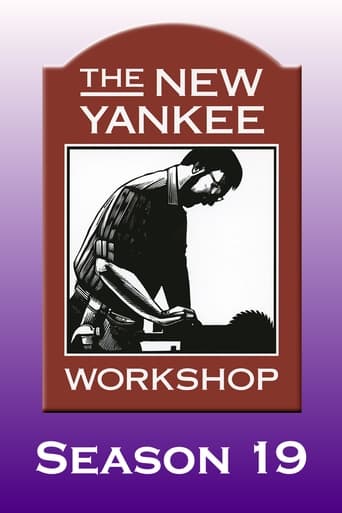
Season 19
Norm builds a giltwood mirror, an entrance door and bowfront chest out of mahogany, an old pine dry sink, a cherry candlestand, a painted Dominy clock, a cowboy sideboard, a painted cupboard, a decoratively-painted taunton chest, a nest of tables, and an upholstered window bench. For "shop tools and techniques", he spends two episodes demonstrating the use of the table saw.Window Bench
Episode 13 - 3-31-2007


Nest of Tables
Episode 12 - 3-24-2007


Bowfront Chest
Episode 11 - 3-17-2007


Taunton Chest
Episode 10 - 3-10-2007


Table Saw 101 (2)
Episode 9 - 3-03-2007


Table Saw 101 (1)
Episode 8 - 2-24-2007


Painted Cupboard
Episode 7 - 2-17-2007


Cowboy Sideboard
Episode 6 - 2-10-2007


Dominy Clock
Episode 5 - 2-03-2007


Martha's Candlestand
Episode 4 - 1-27-2007


Old Pine Dry Sink
Episode 3 - 1-20-2007


Entrance Door
Episode 2 - 1-13-2007


Giltwood Mirror
Episode 1 - 1-06-2007


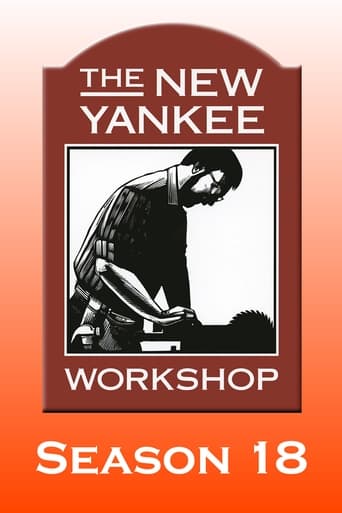
Season 18
Norm builds a colonial-style mantel, plantation shutters, a poker table and wall-hung console out of mahogany, a walnut shop clock, a white oak corner table, a Greek revival bookcase, a storage shed, a cherry corner chair, and wall paneling. For "shop tools and techniques", he spends two episodes demonstrating use of the router and he builds a roller stand, a stock cart, and a mobile tool stand.Wall Paneling
Episode 13 - 4-01-2006


Corner Chair
Episode 12 - 3-25-2006


Wall Hung Console
Episode 11 - 3-18-2006


Storage Shed
Episode 10 - 3-11-2006


Greek Revival Bookcase
Episode 9 - 3-04-2006


Corner Table
Episode 8 - 2-25-2006


Router 101 (2)
Episode 7 - 2-18-2006


Router 101 (1)
Episode 6 - 2-11-2006


New Yankee Shop Clock
Episode 5 - 2-04-2006


Poker Table
Episode 4 - 1-28-2006


Workshop Helpers
Episode 3 - 1-21-2006


Plantation Shutters
Episode 2 - 1-14-2006


Colonial Style Mantel
Episode 1 - 1-07-2006



Season 17
Norm visits Bermuda where he gets ideas to build a bench/table out of cypress and a chest out of mahogany. He also builds an oak hall mirror, an upholstered ottoman, a federal-style game table, a side chair, a cherry tilt top table, a Queen Anne highboy out of tiger maple, yet another kitchen island, carved wooden signs, and the library modular bookshelf system. For "shop tools and techniques", he demonstrates the basics of using the lathe.The Library System
Episode 13 - 3-26-2005


Carved Wooden Signs
Episode 12 - 3-19-2005


Kitchen Island
Episode 11 - 3-12-2005


Highboy (2)
Episode 10 - 3-05-2005


Highboy (1)
Episode 9 - 2-26-2005


Tilt Top Table
Episode 8 - 2-19-2005


Side Chair
Episode 7 - 2-12-2005


Lathe 101
Episode 6 - 2-05-2005


Federal-Style Game Table
Episode 5 - 1-29-2005


Bermuda Chest
Episode 4 - 1-22-2005


Ottoman
Episode 3 - 1-15-2005


Bermuda Bench/Table
Episode 2 - 1-08-2005


Hall Mirror
Episode 1 - 1-01-2005


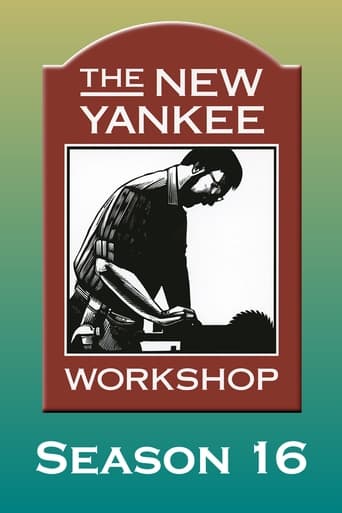
Season 16
Norm builds a butterfly table, a Shaker bookcase, and a lowboy out of cherry, a folding screen and dining table out of mahogany, a flower stand and gardener's dry sink out of cypress, a tall case oak clock, a decoratively-painted dower chest, a fan back Windsor chair, a painted pier table, and an oak mission-style desk.The Gardener's Dry Sink
Episode 13 - 3-27-2004


The Mission Style Desk
Episode 12 - 3-20-2004


The Dining Table
Episode 11 - 3-13-2004


The Pier Table
Episode 10 - 3-06-2004


The Lowboy
Episode 9 - 2-28-2004


The Windsor Chair (2)
Episode 8 - 2-21-2004


The Windsor Chair (1)
Episode 7 - 2-14-2004


The Dower Chest
Episode 6 - 2-07-2004


The Tall Case Oak Clock
Episode 5 - 1-31-2004


The Shaker Bookcase
Episode 4 - 1-24-2004


The Flower Stand
Episode 3 - 1-17-2004


The Folding Screen
Episode 2 - 1-10-2004


The Butterfly Table
Episode 1 - 1-03-2004


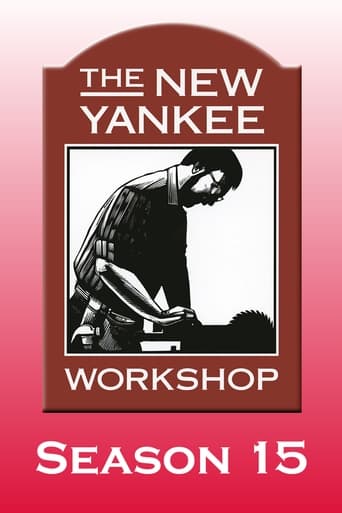
Season 15
Norm makes a pine sheep shearing coffee table, a Queen Anne pedestal table, a cigar chair, a glass cupboard, a maple media press, a Douglas fir flagpole, a mahogany regency headboard, a painted corner hutch out of poplar, and a walnut French side table. For "shop tools and techniques", he builds a deluxe router station and a wall-mounted tool chest.Wall Mounted Tool Chest
Episode 13 - 3-29-2003


French Side Table
Episode 12 - 3-22-2003


Painted Corner Hutch
Episode 11 - 3-15-2003


Regency Headboard
Episode 10 - 3-08-2003


Flagpole
Episode 9 - 3-01-2003


Media Press (2)
Episode 8 - 2-22-2003


Media Press (1)
Episode 7 - 2-15-2003


Beveled Glass Cupboard
Episode 6 - 2-08-2003


Cigar Chair (2)
Episode 5 - 2-01-2003


Cigar Chair (1)
Episode 4 - 1-25-2003


Queen Anne Table
Episode 3 - 1-18-2003


Sheep Shearing Coffee Table
Episode 2 - 1-11-2003


Deluxe Router Station
Episode 1 - 1-04-2003



Season 14
Norm builds a chestnut steamer trunk, an Adirondack loveseat, a tiger maple canopy bed, a cherry shaving stand, a pedestal table and deck chair out of teak, a four-drawer chest, wooden bowls, a cherry and tiger maple nightstand, and a stepback cupboard. For "shop tools and techniques", he builds a miter bench with storage, a work table, and a clamp cart.Stepback Cupboard
Episode 13 - 3-30-2002


Deck Chair
Episode 12 - 3-23-2002


Nightstand
Episode 11 - 3-16-2002


Wooden Bowls
Episode 10 - 3-09-2002


Four Drawer Chest
Episode 9 - 3-02-2002


Pedestal Table
Episode 8 - 2-23-2002


Work Table and Clamp Cart
Episode 7 - 2-16-2002


Shaving Stand
Episode 6 - 2-09-2002


Canopy Bed
Episode 5 - 2-02-2002


Adirondack Loveseat
Episode 4 - 1-26-2002


Steamer Trunk
Episode 3 - 1-19-2002


Miter Bench and Storage (2)
Episode 2 - 1-12-2002


Miter Bench and Storage (1)
Episode 1 - 1-05-2002


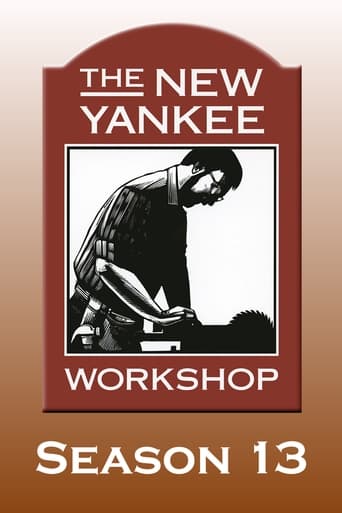
Season 13
Norm builds a white oak hall seat, a pine CD storage case, a cypress garden armchair, an outdoor cupboard, a mahogany dressing table, a mailbox, a bath cupboard, a pine monastery table, and an oak barrister's bookcase. For "shop tools and techniques", he spends two episodes demonstrating jigs and builds a hutch for the workshop.Barrister Bookcase
Episode 13 - 3-31-2001


Monastery Table
Episode 12 - 3-24-2001


Bath Cupboard
Episode 11 - 3-17-2001


Mailbox
Episode 10 - 3-10-2001


Dressing Table (2)
Episode 9 - 3-03-2001


Dressing Table (1)
Episode 8 - 2-24-2001


Outdoor Cupboard
Episode 7 - 2-17-2001


Workshop Hutch
Episode 6 - 2-10-2001


Garden Armchair
Episode 5 - 2-03-2001


CD Storage Case
Episode 4 - 1-27-2001


Hall Seat
Episode 3 - 1-20-2001


Jigs (2)
Episode 2 - 1-13-2001


Jigs (1)
Episode 1 - 1-06-2001


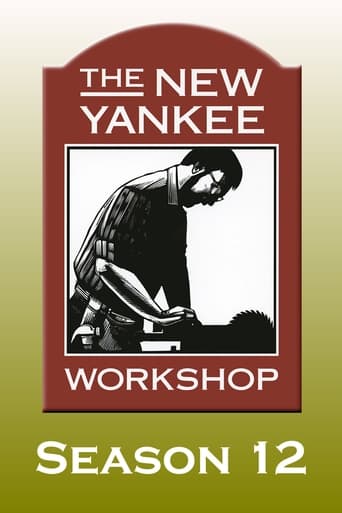
Season 12
Norm builds planter boxes and a bench out of cypress, a croquet set and bench, a hanging porch swing and outdoor patio table out of teak, a computer desk, a mahogany patio trolley, a chestnut desktop writing case, an English server, a jewelry case, and a breakfront cabinet. For "shop tools and techniques", he spends two episodes assembling a garage workshop and builds a sharpening station.Breakfront Cabinet
Episode 13 - 3-25-2000


Jewelry Case
Episode 12 - 3-18-2000


Sharpening Station
Episode 11 - 3-11-2000


English Server
Episode 10 - 3-04-2000


Outdoor Patio Table
Episode 9 - 2-26-2000


Desk Top Writing Case
Episode 8 - 2-19-2000


Patio Trolley
Episode 7 - 2-12-2000


Computer Desk
Episode 6 - 2-05-2000


Hanging Porch Swing
Episode 5 - 1-29-2000


Croquet Set and Bench
Episode 4 - 1-22-2000


Planter Boxes and Bench
Episode 3 - 1-15-2000


Garage Workshop (2)
Episode 2 - 1-08-2000


Garage Workshop (1)
Episode 1 - 1-01-2000


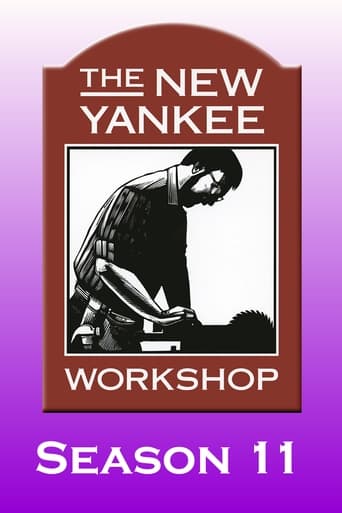
Season 11
Norm builds a number of kitchen-centric projects, including, a kitchen island, a kitchen pantry, a kitchen secretary, a bake center, classic kitchen cabinets, a sink base, a chef's table, and a grill cart. He also builds an old pine hutch, a teak bar, a laundry center, and a press cupboard. For "shop tools and techniques", he builds a table saw station.Grill Cart
Episode 13 - 3-27-1999


Chef's Table
Episode 12 - 3-20-1999


Press Cupboard
Episode 11 - 3-13-1999


Sink Base
Episode 10 - 3-06-1999


Classic Kitchen Cabinets
Episode 9 - 2-27-1999


Table Saw Station
Episode 8 - 2-20-1999


Bake Center
Episode 7 - 2-13-1999


Laundry Center
Episode 6 - 2-06-1999


Teak Bar
Episode 5 - 1-30-1999


Old Pine Hutch
Episode 4 - 1-23-1999


Kitchen Secretary
Episode 3 - 1-16-1999


Kitchen Pantry
Episode 2 - 1-09-1999


Kitchen Island
Episode 1 - 1-02-1999



Season 10
More from Norm's trip to Savannah, Georgia; he builds a pine linen press and a walnut table. Norm also visits Arizona, where he gets ideas to build a white oak Morris chair and a mesquite bookcase. Norm also visits Utah where he gets wood from an old railroad trestle and builds a chaise lounge. He also builds a pine Irish table, a pine library ladder, a pine Irish bar, a barn cupola, a whirligig, and a roll-top desk. For "shop tools and techniques", he builds a chop saw station.Roll Top Desk (2)
Episode 13 - 3-28-1998


Roll Top Desk (1)
Episode 12 - 3-21-1998


Chaise Lounge
Episode 11 - 3-14-1998


Whirligig
Episode 10 - 3-07-1998


Chop Saw Station
Episode 9 - 2-28-1998


Mesquite Bookcase
Episode 8 - 2-21-1998


Cupola
Episode 7 - 2-14-1998


Morris Chair
Episode 6 - 2-07-1998


Old Pine Bar
Episode 5 - 1-31-1998


Library Ladder
Episode 4 - 1-24-1998


Walnut Table
Episode 3 - 1-17-1998


Linen Press
Episode 2 - 1-10-1998


Irish Table
Episode 1 - 1-03-1998


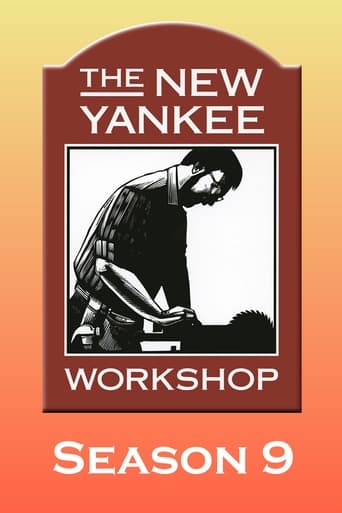
Season 9
Norm visits Savannah, Georgia. Inspired from the trip, he builds a pine planter's desk, a pine turkey table, a tiger maple washstand, a pine carousel table, and a mahogany 7-drawer chest. He also builds a Nantucket settle out of cherry, a pine dough box, a pine garden gate, cherry serving trays, a bent-wood hat rack, and a fireplace mantel. Finally, he tackles a major project - building a greenhouse.Fireplace Mantle
Episode 13 - 3-29-1997


Greenhouse (2)
Episode 12 - 3-22-1997


Greenhouse (1)
Episode 11 - 3-15-1997


Hat Rack
Episode 10 - 3-08-1997


Seven Drawer Chest
Episode 9 - 3-01-1997


Carousel Table
Episode 8 - 2-22-1997


Serving Trays
Episode 7 - 2-15-1997


Garden Gate
Episode 6 - 2-08-1997


Dough Box
Episode 5 - 2-01-1997


Tiger Maple Washstand
Episode 4 - 1-25-1997


Nantucket Settle
Episode 3 - 1-18-1997


Turkey Table
Episode 2 - 1-11-1997


Planter's Desk
Episode 1 - 1-04-1997



Season 8
Norm takes a trip to California wine country. Inspired from his trip, he builds a chestnut coffee table, a pine paymaster's desk, a pine long table, a pine double dresser, a chestnut desk, an Irish hutch out of pine, and a redwood wine storage unit. He also builds a bedside cupboard, turned table lamps, and a nest of drawers. Finally, he builds a garden shed and recycling center. For "shop tools and techniques", he builds a router table.Router Table
Episode 13 - 3-30-1996


Nest of Drawers
Episode 12 - 3-23-1996


Garden Shed and Recycling Center (2)
Episode 11 - 3-16-1996


Garden Shed and Recycling Center (1)
Episode 10 - 3-09-1996


Three Turned Table Lamps
Episode 9 - 3-02-1996


Wine Storage Unit
Episode 8 - 2-24-1996


Irish Hutch
Episode 7 - 2-17-1996


Chestnut Desk
Episode 6 - 2-10-1996


Double Dresser
Episode 5 - 2-03-1996


Long Table
Episode 4 - 1-27-1996


Paymaster's Desk
Episode 3 - 1-20-1996


Chestnut Coffee Table
Episode 2 - 1-13-1996


Bedside Cupboard
Episode 1 - 1-06-1996


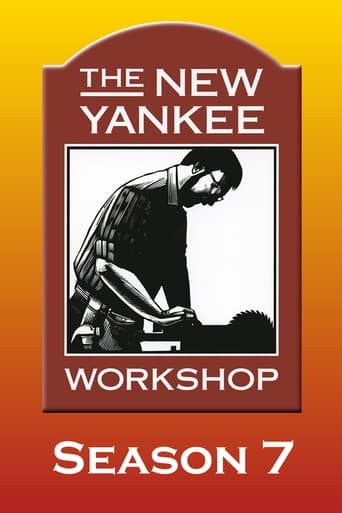
Season 7
Norm tackles a number of larger projects including a Clancy boat and a Gazebo. He also builds a cherry X-brace trestle table, a pine pergola, a mahogany TV tray table, an outdoor garden table and Lutyens bench out of teak, a cherry bathroom vanity, picture frames, a pine quilt rack, and a pine chimney cupboard.Chimney Cupboard
Episode 13 - 4-01-1995


Quilt Racks
Episode 12 - 3-25-1995


Gazebo (2)
Episode 11 - 3-18-1995


Gazebo (1)
Episode 10 - 3-11-1995


Clancy Boat (2)
Episode 9 - 3-04-1995


Clancy Boat (1)
Episode 8 - 2-25-1995


Picture Frames
Episode 7 - 2-18-1995


Lutyens Bench
Episode 6 - 2-11-1995


Cherry Bathroom Vanity
Episode 5 - 2-04-1995


Outdoor Garden Table
Episode 4 - 1-28-1995


TV Tray Table
Episode 3 - 1-21-1995


Pergola
Episode 2 - 1-14-1995


X-Brace Trestle Table
Episode 1 - 1-07-1995


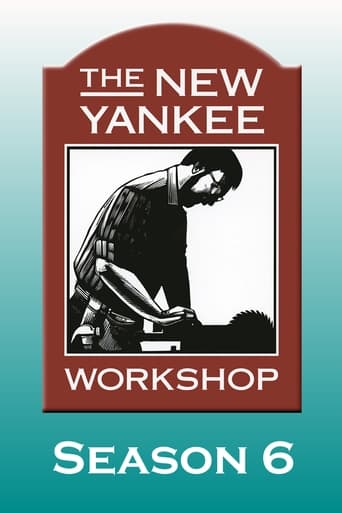
Season 6
Norm builds a number of child-related projects, including an easel, a doll house, a maple and mahogany toy chest, a cradle out of cherry, a trundle bed, a marble roll, a rocking chair, an alphabet wagon, a high chair, and a playhouse. He also builds storage units and a student's desk out of oak.Playhouse (2)
Episode 13 - 3-26-1994


Playhouse (1)
Episode 12 - 3-19-1994


High Chair
Episode 11 - 3-12-1994


Alphabet Wagon
Episode 10 - 3-05-1994


Rocking Chair
Episode 9 - 2-26-1994


Student's Desk
Episode 8 - 2-19-1994


Storage Units: Bureau/Cupboard and Bookcase
Episode 7 - 2-12-1994


Marble Roll
Episode 6 - 2-05-1994


Trundle Bed
Episode 5 - 1-29-1994


Cradle
Episode 4 - 1-22-1994


Toy Chest
Episode 3 - 1-15-1994


Doll House
Episode 2 - 1-08-1994


Easel
Episode 1 - 1-01-1994


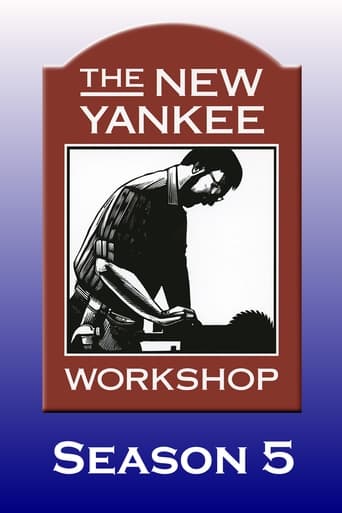
Season 5
Norm builds a Victorian kitchen table out of pine, a plant stand out of pine, an oak Delft rack, an oak coffee table, cypress outdoor planters, a pantry table, a white oak sideboard, a pine hanging corner cupboard, a pine cupboard, a poplar and maple butcher block, a redwood arbor, a pine secretary desk, and a tall pine clock.Tall Pine Clock
Episode 13 - 3-27-1993


Secretary Desk
Episode 12 - 3-20-1993


Redwood Arbor
Episode 11 - 3-13-1993


Butcher Block
Episode 10 - 3-06-1993


Pine Cupboard
Episode 9 - 2-27-1993


Hanging Corner Cupboard
Episode 8 - 2-20-1993


Sideboard
Episode 7 - 2-13-1993


Pantry Table
Episode 6 - 2-06-1993


Outdoor Planters
Episode 5 - 1-30-1993


Oak Coffee Table
Episode 4 - 1-23-1993


Delft Rack
Episode 3 - 1-16-1993


Plant Stand
Episode 2 - 1-09-1993


Victorian Kitchen Table
Episode 1 - 1-02-1993


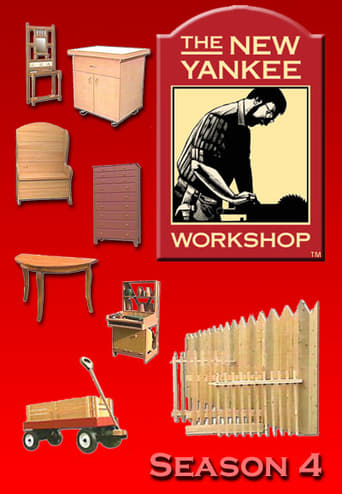
Season 4
Norm builds a cypress outdoor lidded bench, a child's wagon, a pallet-wood coffee table, a redwood gardener's work bench, a Shaker tall chest, white cedar colonial fences, a pine console table, an oak wheelbarrow, an oak umbrella stand, a maple and pine turned-post bed, a dove cote, and a cherry ladderback chair. For "shop tools and techniques", he builds a rolling shop cabinet.Ladder-back Chair
Episode 13 - 3-28-1992


Dove Cote
Episode 12 - 3-21-1992


Turned Post Bed
Episode 11 - 3-14-1992


Umbrella Stand
Episode 10 - 3-07-1992


Wheelbarrow
Episode 9 - 2-29-1992


Console Table
Episode 8 - 2-22-1992


Colonial Fences
Episode 7 - 2-15-1992


Shaker Tall Chest
Episode 6 - 2-08-1992


Gardener's Workbench
Episode 5 - 2-01-1992


Coffee Table
Episode 4 - 1-25-1992


Child's Wagon
Episode 3 - 1-18-1992


Outdoor Lidded Bench
Episode 2 - 1-11-1992


Rolling Shop Cabinet
Episode 1 - 1-04-1992


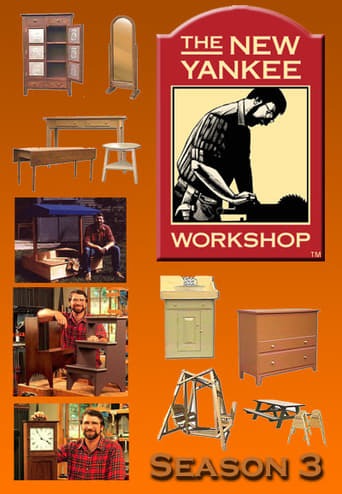
Season 3
Norm builds a number of Shaker-inspired projects: step stools out of pine and cherry, a painted two-drawer blanket chest, a pine washstand, a walnut wall clock, a pine woodbox, and a cherry library table. He also builds a picnic table and sawhorses out of 2x6 stock, a sandbox, a cherry harvest table, a redwood garden swing, a cricket table, a pie safe, and a mahogany standing mirror.Standing Mirror
Episode 13 - 3-30-1991


Pie Safe with Punched Tin Front
Episode 12 - 3-23-1991


Cricket Table
Episode 11 - 3-16-1991


Garden Swing
Episode 10 - 3-09-1991


Library Table
Episode 9 - 3-02-1991


Shaker Woodbox
Episode 8 - 2-23-1991


Harvest Table
Episode 7 - 2-16-1991


Sandbox
Episode 6 - 2-09-1991


Shaker Wall Clock
Episode 5 - 2-02-1991


Shaker Washstand
Episode 4 - 1-26-1991


Shaker Two Drawer Blanket Chest
Episode 3 - 1-19-1991


Picnic Table and Saw Horses
Episode 2 - 1-12-1991


Shaker Step Stools
Episode 1 - 1-05-1991



Season 2
Norm builds an ash rocking horse, a cypress Adirondack chair, a mahogany butler's table, a pine kitchen dresser, a pine hearthside settle, a poplar pencil-post bed, a maple and poplar chair table, a pine kitchen worktable, an oak mission-style sofa, a Chippendale mirror, a cherry chest-on-chest, a teak English garden bench, and an armoire entertainment center.Armoire (Entertainment Center)
Episode 13 - 3-31-1990


English Garden Bench
Episode 12 - 3-24-1990


Chest on Chest
Episode 11 - 3-17-1990


Chippendale Mirror
Episode 10 - 3-10-1990


Mission Style Sofa
Episode 9 - 3-03-1990


Kitchen Worktable
Episode 8 - 2-24-1990


Chair Table
Episode 7 - 2-17-1990


Pencil-Post Bed
Episode 6 - 2-10-1990


Hearthside Settle
Episode 5 - 1-03-1990


Kitchen Dresser
Episode 4 - 1-27-1990


Butler's Table
Episode 3 - 1-20-1990


Adirondack Chair
Episode 2 - 1-13-1990


Rocking Horse
Episode 1 - 1-06-1990



Season 1
First Season of the Series. Series host, Norm Abram, builds an oak medicine cabinet, an ash drop-leaf table, a pine blanket chest, a pine bedside table, an oak bathroom vanity, a cherry trestle table, a painted bookcase, a pine chest of drawers, a candle stand, a pine hutch, a maple slant-top writing desk, and a pine corner cupboard. For "shop tools and techniques", he builds a workbench.Corner Cupboard
Episode 13 - 4-01-1989


Writing Desk
Episode 12 - 3-25-1989


Hutch
Episode 11 - 3-11-1989


Candle Stand
Episode 10 - 3-11-1989


Chest of Drawers
Episode 9 - 3-04-1989


Bookcase
Episode 8 - 2-25-1989


Trestle Table
Episode 7 - 2-18-1989


Oak Bathroom Vanity
Episode 6 - 2-11-1989


Bedside Table
Episode 5 - 2-04-1989


Blanket Chest
Episode 4 - 1-28-1989


Drop Leaf Table
Episode 3 - 1-21-1989


Workbench
Episode 2 - 1-14-1989


Medicine Cabinet
Episode 1 - 1-07-1989
 8.8/10
8.8/10


Medicine Cabinet
Episode 1 - 1-07-1989
 8.8/10
8.8/10


